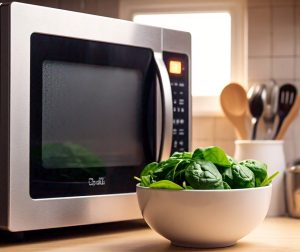We can transform kale, spinach, and other leafy greens into tender, tasty sides in just 2-5 minutes using a microwave.
This method is not only quick but also helps in retaining more nutrients compared to boiling or long steaming.
We’ll show you how to make cheesy parmesan kale, savory garlic kale, perfectly steamed kale, and effortless spinach.
Jump To:
Quick & Cheesy Microwave Parmesan Kale
We’ve discovered that combining parmesan cheese with microwaved kale creates an irresistible side dish that’s ready in under 3 minutes. The cheese melts beautifully over the warm kale, creating a creamy coating that makes even the most stubborn greens-avoiders come back for seconds.
Start by washing 4-5 large kale leaves and removing the thick stems. Tear the leaves into bite-sized pieces and place them in a microwave-safe bowl with 2 tablespoons of water.
Microwave on high for 90 seconds, then immediately sprinkle 1/4 cup of freshly grated parmesan cheese over the hot kale. The residual heat will melt the cheese perfectly. From our experience, pre-grated cheese works fine, but freshly grated creates a smoother, more luxurious texture.
One mistake we made early on was adding too much water – this dilutes the cheese flavor. Stick to just 2 tablespoons for the perfect steam-to-cheese ratio.
Savory Microwave Garlic Kale in Minutes
Garlic transforms plain kale into a restaurant-quality side dish that pairs beautifully with any protein. We’ve found that using fresh garlic gives the best flavor punch, though garlic powder works in a pinch.
Prepare your kale the same way – wash, destem, and tear into pieces. Place in a microwave-safe bowl with 2 tablespoons of water and 2 minced garlic cloves.
Microwave for 2 minutes on high power. The garlic will infuse the steam, creating an aromatic cloud that makes your kitchen smell amazing. After microwaving, drizzle with 1 teaspoon of olive oil and a pinch of salt.
What we found works best is letting the garlic sit in the water for 30 seconds before microwaving – this prevents the garlic from burning and gives it time to release its oils. I strongly suggest avoiding garlic salt here since the natural garlic flavor is so much more vibrant.
How to Perfectly Steam Kale in Your Microwave
Steaming kale in the microwave preserves its vibrant green color and maintains maximum nutritional value. This technique works for any type of kale – curly, lacinato, or red Russian varieties.
The key is using the right water-to-greens ratio and covering properly. Place your prepared kale in a microwave-safe bowl with exactly 3 tablespoons of water for every 4 cups of torn leaves.
Cover tightly with microwave-safe plastic wrap, leaving one corner slightly vented. Microwave on high for 2-3 minutes depending on how tender you prefer your greens. The steam created will cook the kale evenly from all sides.
From my own experience, the biggest mistake is overcooking – kale goes from perfectly tender to mushy very quickly. Start with 2 minutes, then check and add 30-second intervals if needed. The leaves should be bright green and easily pierced with a fork when done.
Also See: Quick & Healthy: 2-minute Microwave Pumpkin Mug Cake
Effortless Microwave Spinach: A How-to Guide
Spinach is hands-down the easiest green to microwave, and we’ve perfected this technique after countless trials in our kitchen. Baby spinach wilts incredibly fast, so timing is everything here – just 60-90 seconds and you’re done!
Start with fresh baby spinach (about 4-5 cups) and give it a quick rinse. Here’s what I learned the hard way: don’t shake off all the water. Those little droplets clinging to the leaves create the perfect steam environment.
Place the damp spinach in a large microwave-safe bowl – and I mean large because spinach takes up space initially. Microwave on high for 60 seconds, then check. The leaves should be completely wilted and bright green.
From my own experience, mature spinach with thicker stems needs an extra 30 seconds, while delicate baby spinach can overcook in a flash. What I found works best is adding a tiny pinch of salt before microwaving – it helps draw out moisture and prevents that watery mess at the bottom of the bowl.
Essential Tools for Microwaving Greens
We’ve learned that having the right equipment makes all the difference between perfectly cooked greens and disappointing results. After years of trial and error, these are the tools that never let us down.
Microwave-Safe Glass Bowls: Pyrex or similar heat-resistant glass bowls work best. We recommend at least 2-quart capacity because greens need room to steam properly. Plastic containers can warp from the steam heat – trust me, I’ve melted a few lids this way.
Microwave-Safe Plate or Vented Cover: A simple microwave-safe plate works as a cover, but vented microwave covers are game-changers. They prevent splattering while allowing just enough steam to escape. One mistake I made early on was using regular plastic wrap without venting – the pressure buildup creates a mess.
Fine-Mesh Strainer: This might seem obvious, but a good strainer is crucial for washing your greens thoroughly. Gritty spinach or sandy kale ruins the entire dish. I strongly suggest the basket-style strainers that fit in your sink bowl.
Tongs or Fork: You’ll need these for stirring and checking doneness. Metal tongs work fine since you’re not putting them in the microwave during cooking. What I found works best is keeping them nearby so you can quickly toss the greens if they’re cooking unevenly.
Adjusting Cook Times for Different Greens
Not all greens are created equal, and we’ve spent considerable time figuring out the perfect timing for each type. The thickness of leaves and moisture content dramatically affect cooking times.
Delicate Greens (60-90 seconds): Baby spinach, arugula, and young lettuce leaves cook lightning-fast. These tender greens wilt almost instantly, so start checking at 60 seconds. I’ve overcooked countless batches by assuming they needed more time.
Medium Greens (2-3 minutes): Swiss chard, mature spinach, and bok choy fall into this category. Their stems are thicker but still tender. What I found works best is separating the stems from leaves and giving stems a 30-second head start.
Tough Greens (3-4 minutes): Kale, collard greens, and mustard greens need the longest cooking time. These hardy leaves have thick stems and waxy coatings that resist steam penetration. From my own experience, massaging kale leaves with a tiny bit of oil before microwaving breaks down the tough fibers.
Extra-Thick Greens (4-5 minutes): Mature collards and turnip greens are the toughest customers. They might need multiple rounds of cooking with stirring in between. One mistake I made was trying to rush these – undercooked tough greens are unpleasantly chewy and bitter.
Power level matters too. We always use high power (100%) for the initial cook, but if your microwave runs hot, try 80% power and extend the time by 30-45 seconds. Every microwave behaves differently, so keep notes on what works for your specific model.
Ready to Transform Your Greens Game?
We’ve shared four fantastic ways to cook your favorite greens using just your microwave. From crispy Parmesan kale to perfectly steamed spinach, these methods prove that delicious, nutritious greens are always within reach. No more excuses about complicated cooking or lengthy prep times.
Grab your favorite leafy greens and give these techniques a spin. Start with whichever method sounds most appealing to you. We guarantee you’ll be amazed at how quick and flavorful microwave greens can be. Your taste buds and your busy schedule will thank you!







